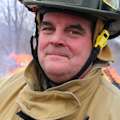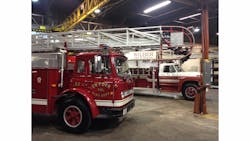It is clear Smeal is poised for some serious growth. In a time when some other fire apparatus manufacturers are closing plants, or closing all together, Smeal has been acquiring businesses and adding staff.
It was apparent at a product and technology showcase last week that the 50-year-old company is not your grandfather’s, or even father’s Smeal. The company, which continues to be owned by its namesake family, has new management, new products and a whole lot of confidence.
Mark Huber, the company’s new president, made a fortune with a business called PayFlex, which was in the third-party health care payment field focusing on flexible health care payments and COBRA insurance. He said he helped grow the business from $300,000 to $62 million income and sold the business for “a whole lot more."
His business acumen seems just what the company needs as it transitions into a force to be reckoned with.
“We are going to claim our market share,” Huber boldly said. “We have great products, but we had no marketing and terrible distribution.”
Huber said, prior to his arrival, 57 percent of the nation was not covered by Smeal distribution. He and his team are building a dealer network to make sure the entire country has access to Smeal products. All this past summer, press releases announcing new dealerships all over the country were published.
One big goal Huber wants to achieve very soon is eliminating 90 days from out of the delivery cycle. He and his team are also working on making the business lean and mean.
An executive level manager has been put on board to usher in Six Sigma lean manufacturing throughout the company.
During a tour of the facility, management said each apparatus travels a total of 11 miles during assembly. That may not mean much to the average person, but it was explained that it would be like having a sub sandwich travel 210 feet while it being made. It’s just plain wasteful.
The Snyder, Neb. plant has 305,000 square feet of space, more than enough for current production levels and even room for additional growth as the lean manufacturing practices take hold.
And just because the company is moving toward being lean, it doesn’t mean employees will be sacrificed. With 250 employees at its main Snyder plant, there’s plenty of places for people to move about and be absorbed as the business grows. Layoffs or staff reductions are just not part of the Smeal culture.
Tour signs throughout the plant indicate that one of Smeal’s biggest assets is "real people who work hard" and "craftsmen and women who care."
Among more than 130 present and future customers who attended the day-long event, one of the most important reasons expressed for doing business with the company is the personal touch. A chief who has done business with Smeal for years said he’s pleased to know the people welding the metal, threading the pipe for the pump and installing the lights are people he knows. For him, it’s personal.
Walking around the vast plant, delineated by large expansions over decades, there seems to be a geniality among the workers. They work efficiently, but friendly and collegially. One in eight employees, or about 20 percent, are firefighters or EMTs. That means people in the plant get it when it comes to fire service and know what fire departments want in terms of service, reliability, options and quality.
During the tour, the plant was abuzz as 30 different apparatus, including dozens of pumpers and several aerials made their way through the plant.
There are still Smeal family members in management positions and on the floor making products.
Huber brings to that culture professionalism and focus to take the business started by the late Don Smeal back in the 1960s to the next level.
Smeal is still owned by the namesake family, Huber stresses, noting that Delwin Smeal, the founder’s son, retired last year at 67 years old. Huber said there was no one in the third generation ready to step up to run the progressively complex business, so the family made the decision to hire new management.
“We have a real opportunity to go someplace,” Huber said. “We’re as good as anyone else out there.”
Huber readily acknowledges that he’s not a classic fire truck guy, and knows there are some who might be critical of his lack of pedigree in the fire service industry, but he’s OK with that.
“I am not here telling them how to build fire trucks,” Huber said. “We have over 440 years of fire truck building experience here.”
While he might not be a fire truck builder, he is an astute businessman. He knows an opportunity when he sees it. He’s picked up key management people from competitors who are eager to lend their expertise to make Smeal even more successful.
“They’re coming here to Snyder, Neb.,” Huber said. “That must mean we’re doing something right.”
Huber and the management team saw another opportunity and purchased US Tanker in Delavan, Wis., a company well-known for quality, stainless-steel tankers and pumpers. That acquisition added another 50,000 square feet of manufacturing capacity and another 30 employees. More importantly, it filled a gap in Smeal’s product line up – tankers.
Previously, Smeal didn’t focus much attention on tankers, but are now able to offer tankers to aerials and everything between, including lots of pumpers.
In June, Smeal acquired the assets of Ladder Towers Inc. (LTI) when American LaFrance went belly up.
That acquisition provided Smeal with the intellectual property and some inventory of a well-known aerial builder with a long history and distinguished products like Squrt, TeleSqurt and Snorkel, not to mention LTI ladders, platforms and tractor-drawn aerials. The acquisition also meant the company acquired a plant in Ephrata, Pa., and its 20 employees.
“We went into the plant and literally swept up the assets off the floor,” Huber said.
LTI was idled when its parent company, American LaFrance abruptly closed and went out of business in January.
Huber explained that Smeal did not get the company name Ladder Towers Inc., but he said the company no longer exists and Smeal got all of the assets. Smeal changed the name of the division to Ladder Tower Company and developed a logo that at first glance looks exactly like the LTI logo, changing only the “I” to a “C.”
It's a good fit, Huber said, providing Smeal with the most comprehensive array of aerials in the world. Smeal was already well known for its aerial having made components for some of the biggest names in the fire apparatus world. Smeal aerials have also served as models for other manufacturers.
That’s why Smeal can boast they have the “source DNA” for most of the steel aerials in the United States.
The strategic acquisitions and alliances didn’t stop there. In September, Smeal became the exclusive North American marketing and distribution partner for Danko Emergency Equipment, literally a neighbor in Snyder.
Danko makes quick attack and quick response apparatus, polypropylene tankers, stainless steel tankers, wildland flatbed units, airport crash trucks and in-plant fire trucks. All in all Danko makes unique, specialized apparatus that further expands Smeal’s offerings.
And, as not to omit any part of the Smeal empire, the company has a 50,000-square-foot satellite facility in Neligh, Neb., about an hour and half northwest of Snyder that employs about 20 people. In that plant, aerial bodies, torque box assemblies and out rigger beams are constructed and then transported to Snyder for final assembly.
Huber said Smeal decided to hold the product and technology showcase as to not lose the momentum the acquisitions have brought to the company. They want to make sure the word is out to the fire service that Smeal is an apparatus builder that can produce just about anything fire departments need and they are on the move to claim more market share.
“Eight weeks ago, this event was a dream,” Huber said to the crowd gathered in the apparatus show room. “This is evidence that we can do what we say we’re going to do.”
About the Author

Ed Ballam
Ed Ballam served as associate editor for Firehouse. He is the assistant chief of the Haverhill Corner, N.H. Fire Department, and a National Registered EMT. He is also a Deputy Forest Fire Warden for the New Hampshire Division of Forests and Lands. Professionally, he's been a journalist for over 35 years working for a variety of publications, including employment as managing editor of a national fire service trade journal for more than a decade.
